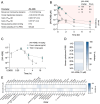This is a preprint.
The Mac1 ADP-ribosylhydrolase is a Therapeutic Target for SARS-CoV-2
- PMID: 39149230
- PMCID: PMC11326214
- DOI: 10.1101/2024.08.08.606661
The Mac1 ADP-ribosylhydrolase is a Therapeutic Target for SARS-CoV-2
Abstract
SARS-CoV-2 continues to pose a threat to public health. Current therapeutics remain limited to direct acting antivirals that lack distinct mechanisms of action and are already showing signs of viral resistance. The virus encodes an ADP-ribosylhydrolase macrodomain (Mac1) that plays an important role in the coronaviral lifecycle by suppressing host innate immune responses. Genetic inactivation of Mac1 abrogates viral replication in vivo by potentiating host innate immune responses. However, it is unknown whether this can be achieved by pharmacologic inhibition and can therefore be exploited therapeutically. Here we report a potent and selective lead small molecule, AVI-4206, that is effective in an in vivo model of SARS-CoV-2 infection. Cellular models indicate that AVI-4206 has high target engagement and can weakly inhibit viral replication in a gamma interferon- and Mac1 catalytic activity-dependent manner; a stronger antiviral effect for AVI-4206 is observed in human airway organoids. In an animal model of severe SARS-CoV-2 infection, AVI-4206 reduces viral replication, potentiates innate immune responses, and leads to a survival benefit. Our results provide pharmacological proof of concept that Mac1 is a valid therapeutic target via a novel immune-restoring mechanism that could potentially synergize with existing therapies targeting distinct, essential aspects of the coronaviral life cycle. This approach could be more widely used to target other viral macrodomains to develop antiviral therapeutics beyond COVID-19.
Conflict of interest statement
A.R.R, P.J., R.L.G., T.T., M.R., J.S.F., G.J.C., B.K.S., R.J.N, A.A., M.D., P.C.O., Y.D.P., N.K., M.O., T.Y.T., R.S., F.Z.B., and M.M. are listed as inventors on a patent application describing small molecule macrodomain inhibitors, which includes compounds described herein. T.Y.T and M.O. are listed as inventors on a patent application filed by the Gladstone Institutes that covers the use of pGLUE to generate SARS-CoV-2 infectious clones and replicons. The Krogan laboratory has received research support from Vir Biotechnology, F. Hoffmann-La Roche and Rezo Therapeutics. N.J.K. has financially compensated consulting agreements with Maze Therapeutics and Interline Therapeutics. He is on the Board of Directors and is President of Rezo Therapeutics and is a shareholder in Tenaya Therapeutics, Maze Therapeutics, Rezo Therapeutics, GEn1E Lifesciences and Interline Therapeutics. B.K.S is co-founder of BlueDolphin LLC, Epiodyne Inc, and Deep Apple Therapeutics, Inc., and serves on the SRB of Genentech, the SAB of Schrodinger LLC, and the SAB of Vilya Therapeutics. M.O. is a cofounder of Directbio and board member of InVisishield. A.R.R. is a co-founder of TheRas, Elgia Therapeutics, and Tatara Therapeutics, and receives sponsored research support from Merck, Sharp and Dohme. A.A. is a co-founder of Tango Therapeutics, Azkarra Therapeutics and Kytarro; a member of the board of Cytomx, Ovibio Corporation, Cambridge Science Corporation; a member of the scientific advisory board of Genentech, GLAdiator, Circle, Bluestar/Clearnote Health, Earli, Ambagon, Phoenix Molecular Designs, Yingli/280Bio, Trial Library, ORIC and HAP10; a consultant for ProLynx, Next RNA and Novartis; receives research support from SPARC; and holds patents on the use of PARP inhibitors held jointly with AstraZeneca from which he has benefited financially (and may do so in the future). J.S.F. is a consultant to, shareholder of, and receives sponsored research support from Relay Therapeutics.
Figures





References
-
- Bao L, Deng W, Huang B, Gao H, Liu J, Ren L, et al. The pathogenicity of SARS-CoV-2 in hACE2 transgenic mice. Nature. 2020. Jul;583(7818):830–3. - PubMed
Publication types
Grants and funding
LinkOut - more resources
Full Text Sources
Medical
Miscellaneous
